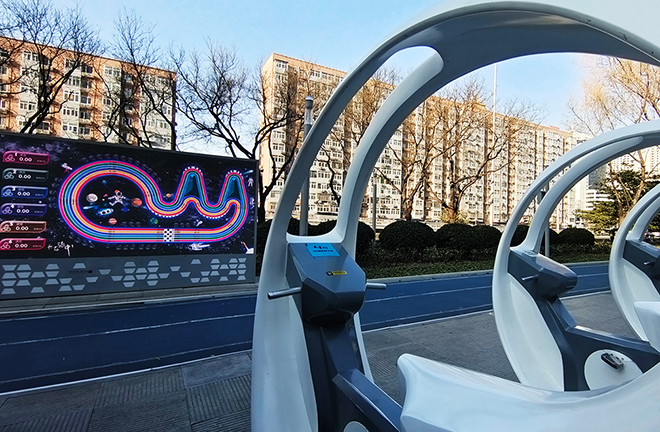Integrating industrial digitalization and digital industrialization

A digital track in Beijing Photo: CFP
At present, the digital economy’s development is profoundly changing operation and governance modes for economic society. The transboundary flow of digital resources allows digital innovation to become a key factor driving the economic system’s reconstruction. Digitalization refers to the role of advanced digital technologies in promoting the economy. Digital technologies’ progress is the core driving force promoting the long-term development of the digital economy, which is closely related to the industrial economic structure and determines its future competitiveness.
Merging digital technologies with traditional industries may lead to two shifts. The first is “complementary integration.” Production factors are connected to non-productive value-added activities, resulting in a number of new industrial forms. The second shift is “optimized integration.” Production factors flow into productive value-added activities, alter the labor-intensive production, decompose large-scale assembly line operations, redefine industrial scale effects, reduce costs, and improve efficiency, making the “smile curve” flatter.
Traditional industries’ digital transformation and the industrial evolution of digital technologies is an interactive integration process, where traditional industries actively embrace digital technologies and digital technologies are applied in real-time to create value.
Digital and real economy merge
The 14th Five-Year Plan (2021–2025) emphasizes the need to promote the deep integration of the digital economy with the real economy. Only by making overall adjustments to emerging industries and opening up new boundaries of production possibilities, can we continue to form new drivers of high-quality development.
Digital industrialization and industrial digitalization are vital to improving China’s industrial competitiveness. Digital industrialization, a driving force of the digital economy, helps construct iterative evolution and innovation diffusion of digital technologies. Industrial digitalization, an indicator of the digital economy’s influence, demonstrates that digital technologies enhance productivity and improve the efficiency of the allocation of production factors. China’s digital economy reached 39.2 trillion yuan in 2020, accounting for 38.6% of the country’s total GDP. The proportion of digital industrialization and industrial digitalization within the GDP is 7.3% and 31.2%, respectively. As the digital economy enters the stage where data valuation, digital industrialization, industrial digitalization, and digital governance collaboratively develop, significant changes to industrial organization and social forms take place.
Digital industrialization is essential to the digital economy. Behind the transformation of production relations, is the implicit mechanism of the digital economy promoting digital technologies as they merge with traditional industries. The all-round innovation of production, organization, and business models need to add a new “digital innovation” perspective to traditional innovation management theory. In June 2021, the National Bureau of Statistics of China officially released the digital economy’s statistical classification, and its core industries, which divided the digital economy industry into five categories: the digital product manufacturing industry, the digital product service industry, the digital technology application industry, the digital factor driven industry, and the digital efficiency improvement industry. This classification marks the formal establishment of China’s digital industry at the statistical level.
Industrial digitalization is an extension of the digital economy, referring to traditional industries that employ digital technologies and data resources to upgrade their business along the whole chain. The digital technologies employed can improve total factor productivity, break the limitations of time and space through extensive digital connection, and provide the added value of related industries to continuously increase value from digital integration. The role of digital technologies in promoting economic growth has shifted from R&D and manufacturing to application. With the integration and penetration of digital technology along the industrial network, technologies and industrial applications can form a benign interactive innovation and development pattern. Digital development has entered the fast lane.
Benign interaction
Going forward, the digital economy’s vitality should be further released through the integrated development and benign interaction of digital industrialization and industrial digitalization.
The first step is to optimize industrial structures and improve the industrial digitalization level. In terms of supply side governance of the digital economy, we need to explore the supply potential of digital industry, amplify digital technology reform’s diffusion effect, and continuously improve its capacity to expand industrial digitalization.
The second step is to develop digital technologies and promote technological innovation. It is necessary to improve R&D and to strengthen effective transformations of digital technology achievements, stimulate and release the potential of industrial digitization’s demand, constantly promote the construction of a national digital innovation system, and improve China’s total factor productivity.
The third step is to conduct digital industrial planning to facilitate the development of the digital economy. Digital industry planning needs to adjust measures to local conditions, realize the differentiated development of digital industries, and guide traditional industry clusters to carry out digital transformation with policy supports. At the same time, we need to encourage open exploration and leave flexible adjustment space for lower-level planning, so that it can accelerate the integration of digital industry and traditional industry, so as to optimize the digital economic structure and realize industry’s digital upgrade.
The fourth and final step is to enact precise policies to match and enhance industrial digital competitiveness. More attention should be attached to the compatibility of industrial policies. Policy guidance should be given to active digital industry departments, to unleash their initiative and creativity. For those industrial sectors with inadequate digitalization and high correlations upstream and downstream, certain tax concessions and subsidies should be given to enhance their initiative in digital transformation. Through precise policy matching, the competitiveness of relevant industries can be enhanced, and China’s digital economy can be sustainably promoted.
Li Teng and Sun Guoqiang are from the Faculty of Business Administration at Shanxi University of Finance and Economics.
Edited by ZHAO YUAN
